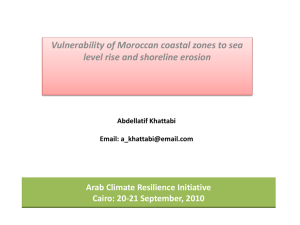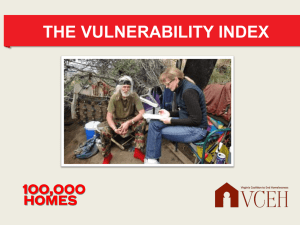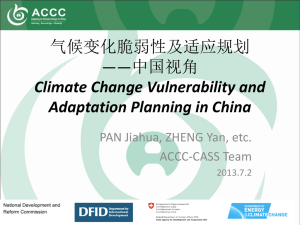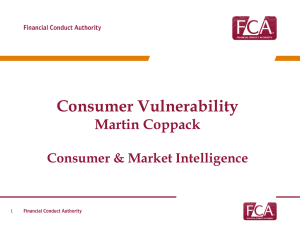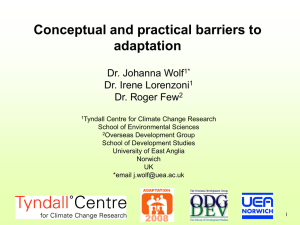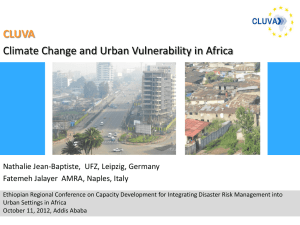Aquifer
advertisement
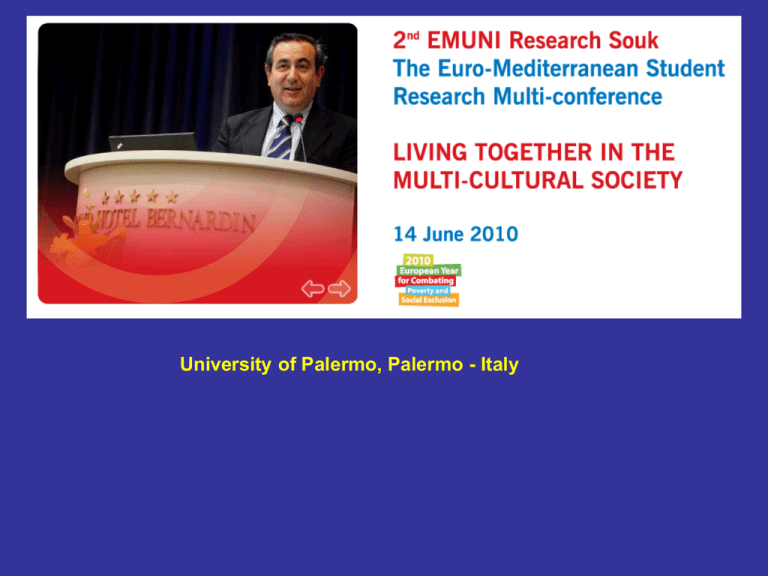
University of Palermo, Palermo - Italy ADVANCED STRATEGIES FOR THE RELIABLE KNOWLEDGE AND MITIGATION OF CONTAMINATION RISK IN COASTAL MEDITERRANEAN ADVANCED STRATEGIES FOR THE RELIABLE KNOWLEDGE AND AQUIFERS MITIGATION OF CONTAMINATION RISK IN COASTAL MEDITERRANEAN AQUIFERS Antonio Cimino, Adolfo Cimino, Antonino Oieni Antonio Cimino,University Adolfo Cimino, Antonino Oieni of Palermo, Italy University of Palermo, Italy cimino@unipa.it; adolfo19@virgilio.it; oieniantonino@gmail.com cimino@unipa.it; adolfo19@virgilio.it; oieniantonino@gmail.com REDUCING THE ENVIRONMENTAL RISKS IN THE NEW CROWDED SOCIETIES: A CONTINUOUS CHALLENGE IN THE EMUNI AREAS TOO The problem of environmental resource availability regards the entire world. It regards also groundwater resources. This problem is spreading also in the economically more developed areas, where accessibility to good quality waters becomes more and more difficult. This crisis is rising particularly in the Mediterranean Emuni areas, somewhere affected by advancing desertification. Emuni institutions from 14 countries REDUCING THE ENVIRONMENTAL RISKS IN THE NEW CROWDED SOCIETIES: A CONTINUOUS CHALLENGE IN THE EMUNI AREAS TOO Solution efforts are really hard, and the exigency of suitable surveying techniques is currently recognized. Rational managing of the whole water resources is suggested by many researchers, also considering both traditional and non conventional water reserves, respectively represented by aquifers and wastewaters or sea-waters laundering. Emuni institutions from 14 countries REDUCING THE ENVIRONMENTAL RISKS IN THE NEW CROWDED SOCIETIES: A CONTINUOUS CHALLENGE IN THE MEDITERRANEAN EMUNI AREAS TOO This problem has become heavy in the Mediterranean coastal megalopolis in more or less advanced phases of maturity, where the advanced urbanization and the relevant high water demand affect the evolution of consumptions and the accessibility itself to this precious resource. Thus, the perspectives of ulterior development - as respect to an evolutionary saturation appear less and less likely, with a necessary redistribution in various spaces of human resources and, therefore, of consumptions, with more advanced managerial modalities. The project to which this paper belongs has the main goal to mitigate hydrogeological risk contamination in very crowded sectors of Sicily, mainly located along the coast. Here, groundwater quality and availability are strongly influenced by climatic changes, aquifer overdrafts and heavy anthropization of the territory. ENVIRONMENTAL RISK OF POLLUTION OF GROUNWATERS IN NORTHERN SICILY Sicily region includes noticeable karst and alluvial aquifers, abundantly described by numerous specific papers, which provide an exhaustive knowledge of their features. In coastal sectors, belonging to the Northern belt of the Island, pollution risk mappings have been performed in GIS environment. Palermo Sicily aquifers have to be considered - as in the Acquedolci and S. Agata di Militello littoral areas real water complex systems, which need a nonconventional analysis of them. Groundwaters are mainly recharged by inland karst relieves, that play also the noticeable role of mitigation against contamination. Authors in this note propose innovative systems for a better zoning and classification of pollution susceptibility. THE ACQUEDOLCI PLAIN, NORTHERN COASTAL BELT Sicily Tyrrhenian Sea 1) Sandy-gravelly-arenaceous complex; 2) sandyarenaceous Quaternary complex; 3) clayey-marlyarenaceous complex; 4) Mesozoic calcareousdolomitic complex; 5) V.E.S.’; 6) bore-holes An ideal test site for a pollution risk estimation is represented by the Acquedolci plain, which lies in the Northern coastal belt of Sicily. It is geologically covered by sandy-gravelly-arenaceous sediments belonging to Quaternary and hosting a productive water-bearing stratum. The plain is bordered by the Tyrrhenian Sea at the North and by steep Mesozoic calcareous dolomitic relieves at the South, these last hydrogeologically supplying the littoral aquifers. BIBLIOGRAPHIC DATA ACCESS DATABASE FIELD DATA SOFTWARE IDRISI, SURFER, AUTOCAD ... GEOREFERENCE TERRITORIAL DATA ORVERLAY ELABORATION SINTACS PARAMETERS WEIGHT STRINGS TERRITORIAL DANGER VULNERABILITY SYNOPTIC SCHEME OF POLLUTION RISK ASSESSMENT RISK QUALITY THE FIRST STEP • PERFORMING SINTACS POLLUTION INTRINSIC VULNERABILITY ASSESSMENT OF AQUIFER (NORTHERN SICILY TEST-SITES) key sentence: “SINTACS method considers scores and weights relevant to typical hydrogeological elements closely affecting the capability of an aquifer to be contaminated by ingestion of dangerous substances hydro-transported from surface” Topographic elements Parameters S Contour lines I N THE SINTACS STANDARD PROCEDURE TO ASSESS POLLUTION VULNERABILITY Hydrography (Civita & De Maio, 2000) T Urbanized areas A THE SINTACS PARAMETERS C Depth to water S Infiltration Multiplying weights Attenuation of the unsaturated zone Typology of the overburden Aquifer features Hydraulic conductivity Slope of topography I SINTACS = 7j=1 Pj Wj Intrinsic vulnerability Procedure to normalize vulnerability classes Normalized and classified Intrinsic vulnerability SINTACS Vulnerability map SINTACS VULNERABILITY MAP OF GROUNDWATER ACQUEDOLCI COASTAL AREA, NORTHERN SICILY Vulnerability rates Vulnerability grade is generally medium to elevated, especially in the alluvial sediments. THE SECOND STEP • PERFORMING GALDIT POLLUTION SPECIFIC VULNERABILITY ASSESSMENT OF AQUIFER (NORTHERN SICILY TEST-SITES) key sentence: “GALDIT method considers the specific seawater intrusion vulnerability, by evaluating six particular elements, all directly influencing sea encroachment events or depending on them” THE GALDIT STANDARD PROCEDURE TO ASSESS POLLUTION VULNERABILITY (Lobo Ferreira et al., 2001-2005) GALDIT HYDROGEOLOGICAL PARAMETERS G Groundwater occurrence (Aquifer Type) A Aquifer hydraulic conductivity L depth to groundwater Level above the sea D I Distance from the shore Impact of existing status of seawater intrusion in the area T Thickness of the aquifer GALDIT SPECIFIC VULNERABILITY MAP OF GROUNDWATER ACQUEDOLCI COASTAL AREA, NORTHERN SICILY 6 6 Wi R / W i 1 i i 1 GALDIT-Index GALDIT vulnerability indexes are generally medium to high, especially in the coastal alluvial sediments 6 1 R1 (3) R2 (4) R3 (4) R4 (1) R5 (2) R6 / Wi i 1 i THE THIRD STEP • PERFORMING POLLUTION VULNERABILITY MAPPING BY FUZZY LOGIC APPLICATION (NORTHERN SICILY TEST-SITES) key sentence: “Implementation of the consequential vulnerability mapping through fuzzy logic software (MATLAB® environment)” FUZZY LOGIC AND MODIFIED SINTACS POLLUTION VULNERABILITY ASSESSMENT The fuzzy logic is a valid approach to solve ambiguity - in deterministic vulnerability assessment - arising from numerous uncertainties inherent to the standards like the mentioned SINTACS. Authors have firstly realized a reduction of the parameters excluding soil, non-saturated and saturated layers, so minimizing acknowledged redundancies in the existing SINTACS application. Pollution vulnerability map of the Acquedolci plain performed by the modified SINTACS method (SICS Release), relevant to four parameters: Depth to water, Net recharge, Hydraulic conductivity, Slope). Fuzzy-logic vulnerability map of the Acquedolci plain (Release SICS) Finally, an implementation of the consequential vulnerability mapping through fuzzy logic software was performed Conclusive considerations • Authors have reviewed the most recent applications of new or modified standards • Pollution vulnerability settings have been performed in the Acquedolci plain test-site aquifer • These experiences have led to a better comprehension of the hydrogeological passive scenery offered by the complex aquifers occurring in the selected area • By fuzzy logic Authors add a further mathematical aid to vulnerability assessment minimizing uncertainties and probabilistic effects due to stochastic hydrogeological parameters The above considerations and outcomes can be replicated in how many possible sectors, giving a universal interest to the exposed procedures to be extended to similar coastal Mediterranean areas of the Emuni environment. Selected references • • • • • • • • • • • Chachadi, A.G. and J. P Lobo Ferriera, 2001. Sea water intrusion vulnerability mapping of aquifers using the GALDIT method. COASTIN, a coastal policy research newsletter, 4: 7-9. Cimino, A., Adolfo Cimino, G. Giunta and A. Oieni 2007. Hydrogeological risk assessment based on natural and anthropic events. International Workshop on Ecological Complex Systems: Stochastic Dynamics and Patterns, Terrasini, Palermo, Italy, 22-26 July, 2007, Book of Abstract, 37. Cimino, A., F. Andolina, S. Cappadona Ignazzitto and Oieni A. 2008. Recenti elaborazioni idrogeologiche e geofisiche nella fascia costiera di Acquedolci - San Fratello (Messina). Acque Sotterranee. 25: 9-23. Cimino, A., C. Cosentino, A. Oieni and L. Tranchina 2007. Applicability of GALDIT assessing vulnerability model in Sicily coastal aquifers. Epitome 2: 185. Cimino, A., F. Fauci, R. Grammauta, D. Gurrera and Oieni A. 2009. Image processing in pollution vulnerability assessment of Sicily aquifers. Epitome 3: 26-27. Cimino, A., Adolfo Cimino and A. Oieni 2010. Vulnerability assessment by fuzzy logic in a coastal aquifer of Northern Sicily. In press. Civita, M. and M. De Maio 2000. Valutazione e cartografia automatica della vulnerabilità degli acquiferi all’inquinamento con il sistema parametrico SINTACS R5. Quaderni di Tecniche di Protezione Ambientale, 72, 226 pp. Bologna, Italy: Pitagora Editor. Kosko, B. 1993. Fuzzy Thinking: The New Science of Fuzzy Logic. New York: Hyperion Books. Morris, B.L., A.R. Lawrence and S.S.D. Foster 1997. Sustainable groundwater management for fast-growing cities: Mission achievable or mission impossible? In: “Groundwater in the Urban Environment”, I: “Problems, Processes and Management”, ed. J. Chilton et al., 55-74. Rotterdam (The Netherlands): A.A. Balkema. Oieni, A., A. Cimino and L. Tranchina 2010. Advances in contamination risk setting of aquifers in Sicily: the karst Nebrodi region. Speleologia Iblea 14. Zadeh, L.A. 1965 - Fuzzy sets. Information and Control. 8: 338-353. Thanks for your attention!



